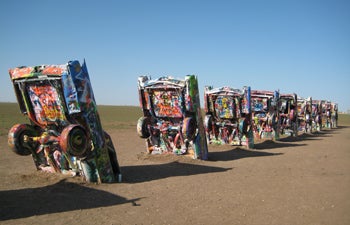Classics Meet Cadillacs
Amy Von Lintel believes art history goes beyond what hangs on the walls of museums, or what fills the pages of textbooks. The field is alive, constantly changing, and much closer to home than you might think.
Beginning this fall, the USC College Ph.D. graduate in art history will share this enthusiasm with students at West Texas A&M University in her new position as assistant professor of art history.
While Von Lintel has realized her goal of teaching in higher education, her career path wasn’t always clear. As an undecided freshman at the University of Kansas, she wavered back and forth between chemistry and history. Then she took an art history course as an elective.
“I was hooked,” Von Lintel said. “It brought together my interest in materials (chemistry) with my passion for history, allowing me to learn and teach history through its visual and material objects.”
It was the opportunity to work with these objects — and with a stellar group of art history faculty members — that drew her to USC after finishing her master’s degree.
Von Lintel cites her hands-on research with texts, photographs and prints at the Getty Research Institute as one of many highlights of her doctoral education. “I get so excited about the art objects and documents…. When I open a box, it’s like a treasure hunt,” she said. “I can’t imagine teaching an art history course that doesn’t deal with seeing and getting to work directly with museum and library materials.”
Her dissertation was focused on the origins of art history in 19th-century Britain and France, and how artistic knowledge was circulated through popular illustrated art books. As books became smaller and cheaper to produce, these first art survey publications became readily available to average citizens unable to travel worldwide to study great works of art, but who could finally examine printed reproductions.
“I love book history, so for me, this project was right up my alley,” Von Lintel said. “It’s something I also think sheds new light on my field. Most art historians pay attention to the way the popular influenced famous artists. I’m interested in the way the field itself had popular origins.”
Professor of Art History Nancy Troy; Professor of History, Art History and Film Vanessa Schwartz; Assistant Professor of Art History Sean Roberts; and former Professor of Art History Malcolm Baker assisted Von Lintel with her out-of-the-box research. She considers the opportunity to work with these scholars as one of the main reasons she was attracted to USC College, and their guidance essential to her education.
“Here, nobody stands in your way to do innovative work,” Von Lintel said. USC, as well as the Los Angeles community as a whole, she noted, are very receptive to new ideas and to taking academic risks. “I’ve felt very supported.”
So moving from L.A. to a small town in Texas seems like quite a big jump for an art history scholar. But Von Lintel would be the first to point out that art is everywhere, not just in Europe or urban America.
“Art history can be local and global,” she said. “It’s the pyramids in Egypt, but it’s also in your backyard.”

Cadillac Ranch, an art installation in Amarillo, Texas. Photo credit Richie Diesterheft.
West Texas A&M, located outside of Amarillo, Texas, is minutes away from the Robert Smithson-designed earthwork Amarillo Ramp, as well as Cadillac Ranch, an art installation consisting of junked Cadillacs buried nose-first in the ground.
“It’s an interesting place,” Von Lintel said. “I’m just blown away by how there are pockets of really great art everywhere.”
Von Lintel plans on weaving local Texas art with the broader art history canon in her Fall 2010 classes. She will combine the past with the present, the near with the far, along with some hands-on exploration, to show her students that art history is a field alive and always relevant to their lives.